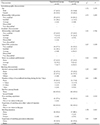Abstract
Background
We aimed to examine the effects of an experiential learning activities-focused smoking prevention (ELSP) program on the basis of the Attitude-Social Influence-Efficacy (ASE) model in elementary school students.
Methods
A non-equivalent control group pre-test and post-test design was conducted with 84 participants who were in the fifth grade of two elementary schools in Seongnam city, South Korea. The two schools were allocated into either the ELSP (n=42) or control (n=42) group. The ELSP group completed five ELSP classes, while the control group completed five traditional lecture-based classes during the 5 weeks. Both groups were examined before and after 5 weeks, using ASE measures of smoking attitude, social influence, self-efficacy for the refusal of smoking temptation, and intention not to smoke. Data were collected from August to September 2017.
Results
The ELSP group had significant changes in the scores of smoking attitude (t=4.75, P<0.001) and social influences (t=3.73, P<0.001), compared to those in the control group. However, the ELSP group had non-significant changes in the scores of self-efficacy for the refusal of smoking temptation and intention not to smoke, compared to those in the control group.
Conclusions
The ELSP program may be effective in improving smoking attitude and perceived social influence of smoking among those in upper grades of elementary schools. However, the duration and intensity of the ELSP program must be revised to effectively enhance smoking refusal self-efficacy and non-smoking intentions.
Figures and Tables
References
1. Korean Health Promotion Institute. Tabacco Control Issue Report. Seoul: Korean Health Promotion Institute;2016.
2. Hahn EJ, Rayens MK, Chaloupka FJ, Okoli CT, Yang J. Projected smoking-related death among U.S. youth: a 2000 update. Chicago: University of Illinois;2002.
3. Kim HO, Jeon MS. The relationship between smoking, drinking and the mental health in adolescents. J Korean Public Health Nurs. 2007; 21(2):217–229.
4. Centers for Disease Control and Prevention (CDC). Current cigarette smoking among adults - United States, 2011. MMWR Morb Mortal Wkly Rep. 2012; 61(44):889–894.
5. Hwang MS. A meta-analysis of adolescent psychosocial smoking prevention programs in the United States - identifying factors associated with program effectiveness. Korean J Health Educ Promot. 2007; 24(5):1–21.
6. Choi JM. Development of a predictive model of adolescent smoking [dissertation]. Seoul: Seoul National University;2000. Korean.
7. Fishbein M, Ajzen I. Belief, attitude, intention and behavior: an introduction to theory and research. Addison-Wesley;1975. p. 578.
8. Kim YH. A study on research trends in the creative experience activities for elementary school. J Educ Innov Res. 2015; 25(3):45–65.
9. Do J, Sung J. The effects of youth activity on sociality development. J Adolesc Welf. 2013; 15(2):145–173.
10. Ussher MH, Owen CG, Cook DG, Whincup PH. The relationship between physical activity, sedentary behaviour and psychological wellbeing among adolescents. Soc Psychiatry Psychiatr Epidemiol. 2007; 42(10):851–856.

11. Ahmed NU, Ahmed NS, Bennett CR, Hinds JE. Impact of a drug abuse resistance education (D.A.R.E) program in preventing the initiation of cigarette smoking in fifth- and sixth-grade students. J Natl Med Assoc. 2002; 94(4):249–256.
12. Kim MH, Cho CM, Chon MY. Effects of a smoking prevention program on primary school students. Korean J Child Health Nurs. 2005; 11(1):63–71.
13. Paek KS. Effects of a smoking prevention education on primary school students. J Korean Acad Community Health Nurs. 2006; 17(2):273–282.
14. An HS, Park IH. The effect of smoking prevention education program based on activities with elementary school students on their knowledge and attitude toward smoking and smoking refusal self-efficacy. J Learn Cent Curric Instr. 2016; 16(5):465–486.
15. Korea Centers for Disease Control & Prevention (KCDC). Korea Youth Risk Behavior Web-Based Survey [Internet]. Cheongju: KCDC;2017. Accessed May 16, 2017. Available from: https://www.cdc.go.kr/yhs/home.jsp.
16. Centers for Disease Control and Prevention (CDC). Youth Tobacco Survey (YTS) [Internet]. Atlanta: CDC;2017. Accessed May 16, 2017. Available from: https://www.cdc.gov/tobacco/data_statistics/surveys/yts/index.htm.
17. Seo YS, Kim YI. Factors affecting smoking middle school students' intention to quit smoking: on the basis of the ASE model. J Korean Acad Community Health Nurs. 2013; 24(4):471–479.

18. Choo J, Kim EK. Application of the ASE model to the assertive behavior of non-smoking college students under secondhand smoke exposure. J Korean Acad Community Health Nurs. 2011; 22(1):1–10.

20. Prochaska JO, DiClemente CC. Transtheoretical therapy: toward a more integrative model of change. Psychol Psychother. 1982; 19(3):276–288.

21. Park SW. Factors related with the intention of smoking abstinence among elementary students in a large city. J Korean Soc Sch Health. 2009; 22(1):49–59.
22. Kim AS, Park JH, Hwang EK, Kim SM, Choi SH, Shin EH, et al. Elementary School Together Health. 1st ed. Seoul: Education of genius;2009. p. 160.
23. Woo OY, Kim MK, Kim YS, Park JS, Shin MS, Yoo NS, et al. Elementary School Together Health. 2nd ed. Seoul: YBM;2011. p. 160.
24. Superintendent of Gyeonggi-do Education. Join us FUN FUN Experience-based Smoking Prevention Program. 1st ed. Suwon: Gyeonggi-do Office of Education Physical and Health Education & Gyeonggi-do Elementary School Health Education Study Society;2016. p. 97.
25. Korea Health Promotion Institute. SENSE Elementary school Smoking Prevention Standard education Program. 1st ed. Seoul: Ministry of Health and Welfare & Korea Health Promotion Institute National Anti-smoking Center;2016. p. 85.
26. Lee JS, Kim HK. Meta-analysis of effectiveness of smoking prevention program for elementary school students. Korean J Health Educ Promot. 2017; 34(4):99–110.

27. Jackson C, Dickinson D. Cigarette consumption during childhood and persistence of smoking through adolescence. Arch Pediatr Adolesc Med. 2004; 158(11):1050–1056.

28. Park SW, Kim JY. Smoking experience and related factors among elementary students in a metropolitan city in korean by design-based analysis. J Korean Soc Matern Child Health. 2007; 11(2):197–210.
29. Statistics Korea. International statistics yearbook [Internet]. Daejeon: Statistics Korea;2017. Accessed March 21, 2019. Available from: http://kosis.kr/statisticsList/statisticsListIndex.do?menuId=M_02_01_01&vwcd=MT_RTITLE&parmTabId=M_02_01_01#SelectStatsBoxDiv.




 PDF
PDF ePub
ePub Citation
Citation Print
Print





 XML Download
XML Download